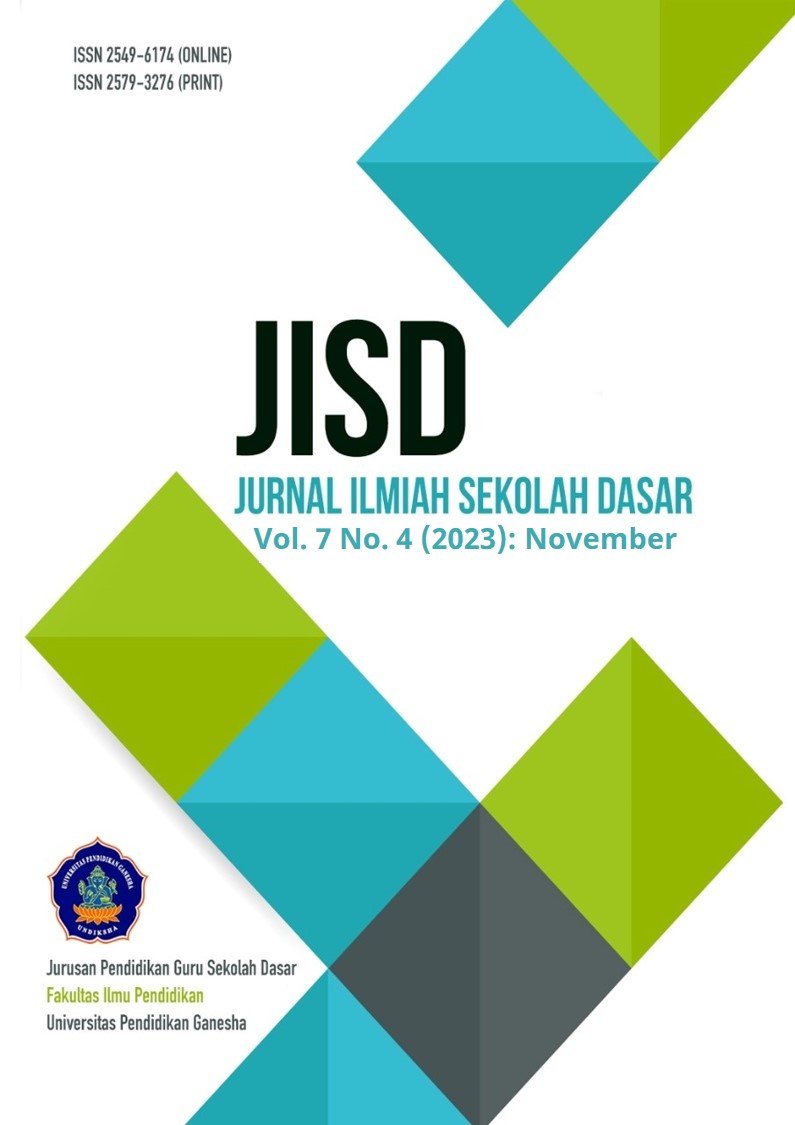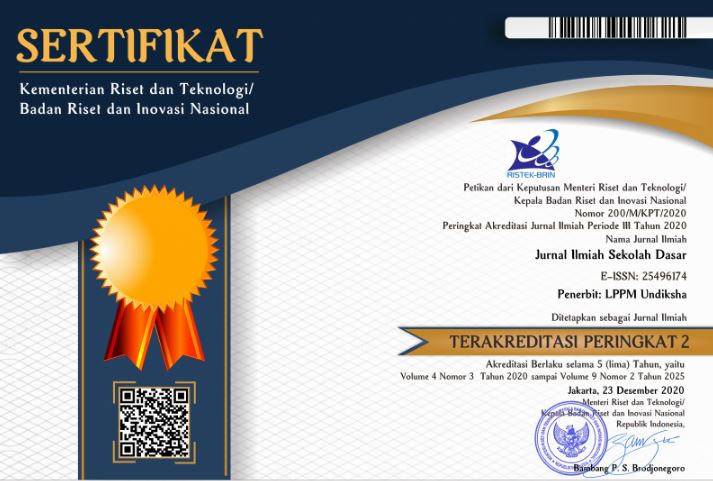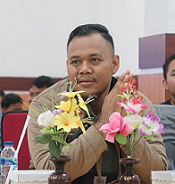Image-Based Textbook About ASEAN Countries with the Integration of Qr-Code Technology in Social Science Content
DOI:
https://doi.org/10.23887/jisd.v7i4.61405Keywords:
Textbooks, QR-CODE Technology Integration, Social StudiesAbstract
The need for textbooks used in schools is one of the causes of learning difficulties among students. This development research aims to create picture-based textbooks about ASEAN countries with the integration of QR-Code technology in social studies content for sixth-grade elementary school students. This research and development uses the Dick & Carey development model. Research subjects are design experts, material experts, teachers, and students. Data collection method using questionnaires. The data analysis technique uses quantitative and qualitative descriptive analysis techniques. The design and material expert validation test results are in the valid category. The practicality test showed very practical results, and the attractiveness test obtained a very attractive product. The development results are included in the effective criteria because student learning outcomes increased from the pretest to an increase during the posttest. Thus, learning using picture-based textbooks about ASEAN countries with QR-Code integration is more effective and improves student learning outcomes compared to not using textbooks. The research conclusions show that picture-based textbooks about ASEAN countries with QR-Code integration for class VI elementary schools are feasible and valid for learning. This research implies that teachers can use picture-based textbooks about ASEAN countries with QR-Code integration to support social studies learning for class VI elementary schools.
References
Adi, N. N. S., Oka, D. N., & Wati, N. M. S. (2021). Dampak Positif dan Negatif Pembelajaran Jarak Jauh di Masa Pandemi COVID-19. Jurnal Ilmiah Pendidikan Dan Pembelajaran, 5(1), 43–48. https://doi.org/10.23887/jipp.v5i1.32803. DOI: https://doi.org/10.23887/jipp.v5i1.32803
Ahdan, S., Putri, A. R., & Sucipto, A. (2020). Aplikasi M-Learning sebagai Media Pembelajaran Conversation pada Homey English. SISTEMASI: Jurnal Sistem Informasi, 9(3), 493–509. https://doi.org/10.32520/stmsi.v9i3.884. DOI: https://doi.org/10.32520/stmsi.v9i3.884
Alfianti, A., Taufik, M., Hakim, Z. R., Sultan, U., & Tirtayasa, A. (2020). Pengembangan Media Pembelajaran IPS Berbasis Video Animasi Pada Tema Indahnya Keragaman Di Negeriku. Indonesian Jurnal of Elementary Education, 2(1), 1–12. https://doi.org/10.31000/ijoee.v1i2.2927.g1791. DOI: https://doi.org/10.31000/ijoee.v1i2.2927
Anugrahana, A. (2020). Hambatan, solusi dan harapan: pembelajaran daring selama masa pandemi covid-19 oleh guru sekolah dasar. Scholaria: Jurnal Pendidikan Dan Kebudayaan, 10(3), 282–289. https://doi.org/10.24246/j.js.2020.v10.i3.p282-289. DOI: https://doi.org/10.24246/j.js.2020.v10.i3.p282-289
Ardiansyah, A. A., & Nana, N. (2020). Peran Mobile Learning Sebagai Inovasi dalam Meningkatkan Hasil Belajar Siswa pada Pembelajaran di Sekolah. Indonesian Journal Of Educational Research and Review, 3(1), 47–56. https://doi.org/10.23887/ijerr.v3i1.24245. DOI: https://doi.org/10.23887/ijerr.v3i1.24245
Aryawan, R., Sudatha, I. G. W., & Sukmana, A. I. W. I. Y. (2018). Pengembangan E-Modul Interaktif Mata Pelajaran IPS Di SMP Negeri 1 Singaraja. Jurnal Edutech Undiksha, 6(2), 180–191. https://doi.org/10.23887/jeu.v6i2.20290.
Cahyani, A., Listiana, I. D., & Larasati, S. P. D. (2020). Motivasi Belajar Siswa SMA pada Pembelajaran Daring di Masa Pandemi Covid-19. IQ (Ilmu Al-Qur’an): Jurnal Pendidikan Islam, 3(1), 123–140. https://doi.org/10.37542/iq.v3i01.57. DOI: https://doi.org/10.37542/iq.v3i01.57
Devirita, F., Neviyarni, N., & Daharnis, D. (2021). Pengembangan Buku Ajar Berbasis Problem Based Learning di Sekolah Dasar. Jurna Basicedu, 5(2), 469–478. https://doi.org/10.31004/basicedu.v5i2.680. DOI: https://doi.org/10.31004/basicedu.v5i2.680
Dewanti, L., & Yasmita, E. M. (2022). Pengembangan Bahan Ajar Tematik Terpadu Berbasis Buku Cerita Bergambar Pada Siswa di SDN 17 Pasar Surantih Pesisir Selatan-Sumatera Barat. Jurnal Ilmiah Hospitality, 11(1), 381–388. https://doi.org/10.47492/jih.v11i1.1622.
Dita, M. A. D. P., Sujana, I. W., & Suniasih, N. W. (2021). Buku Ajar Berbasis Problem Based Learning dan Pengaruhnya terhadap Kemampuan Literasi Siswa Kidal Kelas IV SD. Mimbar PGSD Undikhsa, 9(3), 534–544. https://doi.org/10.23887/jjpgsd.v9i3.42934. DOI: https://doi.org/10.23887/jjpgsd.v9i3.42934
Gustiawati, R., Arief, D., & Zikri, A. (2020). Pengembangan Bahan Ajar Membaca Permulaan dengan Menggunakan Cerita Fabel pada Siswa Sekolah Dasar. Jurnal Basicedu, 4(2), 355–360. https://doi.org/10.31004/basicedu.v4i2.339. DOI: https://doi.org/10.31004/basicedu.v4i2.339
Harahap, A. N., & Abidin, J. (2021). Pengembangan Bahan Ajar Interaktif Berbasis E-Learning Untuk Meningkatkan Hasil Belajar Mahasiswa. JURNAL MathEdu (Mathematic Education Journal), 4(2), 231–235. https://doi.org/10.37081/mathedu.v4i2.2733. DOI: https://doi.org/10.37081/mathedu.v4i2.2733
Haryadi, R., & Selviani, F. (2021). Problematika pembelajaran daring di masa pandemi Covid-19. Academy of Education Journal, 12(2), 254–261. https://doi.org/10.47200/aoej.v12i2.447. DOI: https://doi.org/10.47200/aoej.v12i2.447
Khomarudin, A. N., & Efriyanti, L. (2018). Pengembangan media pembelajaran mobile learning berbasis android pada mata kuliah kecerdasan buatan. Jurnal Educative: Journal of Educational Studies, 3(1), 72–87. https://doi.org/10.30983/educative.v3i1.543. DOI: https://doi.org/10.30983/educative.v3i1.543
Kusumaningrum, P. C. A., Parmiti, D. P., & Wibawa, I. M. C. (2014). Pengaruh Model Pembelajaran Kooperatif Tipe Team Games Tournament (TGT) Terhadap Hasil Belajar IPA Pada Siswa Kelas V Gugus XV Kecamatan Buleleng Tahun Ajaran 2013/2014. Mimbar PGSD Undiksha, 2(1). https://doi.org/10.23887/jjpgsd.v2i1.4532.
Lestari, F., Egok, A. S., & Febriandi, R. (2021). Pengembangan Bahan Ajar Matematika Berbasis Problem Based Learning Pada Siswa Sekolah Dasar. Jurnal Basicedu, 5(1), 394–405. https://doi.org/10.31004/basicedu.v5i1.628. DOI: https://doi.org/10.31004/basicedu.v5i1.628
Libiawati, D., Indihadi, D., & Nugraha, A. (2020). Analisis Kebutuhan Penyusunan Buku Ajar Mata Pelajaran Bahasa Indonesia Berbasis Menulis Teks Eksplanasi. PEDADIDAKTIKA: Jurnal Ilmiah Pendidikan Guru Sekolah Dasar, 7(2), 77–82. https://doi.org/10.17509/pedadidaktika.v7i2.25231. DOI: https://doi.org/10.17509/pedadidaktika.v7i2.25231
Martati, Y. (2020). Prestasi Belajar Akuntansi Dengan Metode Resitasi Bahan Ajar Lembar Kerja Siswa Kelas Xi Akuntansi 2 Smk Negeri 1 Rengat. Journal of Education Informatic Technology and Science, 2(1), 35–44. https://doi.org/10.37859/jeits.v2i3.1880. DOI: https://doi.org/10.37859/jeits.v2i3.1880
Meldina, T., Agustin, A., & Harahap, S. H. (2020). Integrasi Pembelajaran IPS pada Kurikulum 2013 di Sekolah Dasar Institut Agama Islam Negeri Curup Sekolah Dasar Negeri 10 Pasaman. AR-RIAYAH : Jurnal Pendidikan Dasar, 4(1), 16–26. https://doi.org/10.29240/jpd.v4i1.1572. DOI: https://doi.org/10.29240/jpd.v4i1.1572
Mutiara, A., Wagiran, W., & Pristiwati, R. (2022). Pengembangan Buku Pengayaan Elektronik Cerita Fabel Bermuatan Profil Pelajar Pancasila Elemen Gotong Royong Sebagai Media Literasi Membaca di Sekolah Dasar. Jurnal Basicedu, 6(2), 2419–2429. https://doi.org/10.31004/basicedu.v6i2.2455. DOI: https://doi.org/10.31004/basicedu.v6i2.2455
Nurcholis, R. A., & Istiningsih, G. (2021). Problematika dan Solusi Program Literasi Baca-Tulis Siswa Kelas Rendah di SD Negeri Butuh. Jurnal Ilmiah Profesi Pendidikan, 6(2), 189–195. https://doi.org/10.29303/jipp.v6i2.206. DOI: https://doi.org/10.29303/jipp.v6i2.206
Nurhairunnisah, N., & Sujarwo, S. (2018). Bahan ajar interaktif untuk meningkatkan pemahaman konsep Matematika pada siswa SMA kelas X. Jurnal Inovasi Teknologi Pendidikan, 5(2), 192–203. https://doi.org/10.21831/jitp.v5i2.15320. DOI: https://doi.org/10.21831/jitp.v5i2.15320
Puspasari, R., & Suryaningsih, T. (2019). Pengembangan Buku Ajar Kompilasi Teori Graf dengan Model Addie. Journal of Medives : Journal of Mathematics Education IKIP Veteran Semarang, 3(1), 137. https://doi.org/10.31331/medivesveteran.v3i1.702. DOI: https://doi.org/10.31331/medivesveteran.v3i1.702
Putra, M. L. D., & Nurafni, N. (2021). Bahan Ajar Media Aplikasi BAM” Math Genius” Berbasis Android Pada Materi Bangun Datar. MIMBAR PGSD Undiksha, 9(2), 358–366. https://doi.org/10.23887/jjpgsd.v9i2.36511. DOI: https://doi.org/10.23887/jjpgsd.v9i2.36511
Raditya, A., & Iskandar, R. S. F. (2020). Analisis Soal PLSV pada Buku Ajar Matematika dari Kurikulum 1994 hingga Kurikulum 2013. Phenomenon: Jurnal Pendidikan MIPA, 9(2), 232–245. https://doi.org/10.21580/phen.2019.9.2.4066. DOI: https://doi.org/10.21580/phen.2019.9.2.4066
Saragi, R., & Tegeh, I. M. (2022). Media Pembelajaran Berbasis Problem Based Learnig Menggunakan VideoScribe untuk Meningkatkan Hasil Belajar IPS Siswa Kelas V. Jurnal Edutech Undiksha, 10(1), 98–107. https://doi.org/10.23887/jeu.v10i1.41538.
Sari, F. F. K., & Atmojo, I. R. W. (2021). Analisis Kebutuhan Bahan Ajar Digital Berbasis Flipbook untuk Memberdayakan Keterampilan Abad 21 Peserta Didik pada Pembelajaran IPA Sekolah Dasar. Jurnal Basicedu, 5(6), 6079–6085. https://doi.org/10.31004/basicedu.v5i6.1715. DOI: https://doi.org/10.31004/basicedu.v5i6.1715
Savitri, E. N., Amalia, A. V., Prabowo, S. A., Rahmadani, O. E. P., & Kholidah, A. (2021). The Effectiveness of Real Science Mask with QR Code on Students’ Problem-Solving Skills and Scientific Literacy. Jurnal Pendidikan IPA Indonesia, 10(2), 209–219. https://doi.org/10.15294/jpii.v10i2.29918. DOI: https://doi.org/10.15294/jpii.v10i2.29918
Siahaan, M. (2020). Dampak Pandemi Covid-19 Terhadap Dunia Pendidikan. Jurnal Kajian Ilmiah, 1(1), 73–80. https://doi.org/10.31599/jki.v1i1.265. DOI: https://doi.org/10.31599/jki.v1i1.265
Suniasih, N. W. (2019). Pengembangan Bahan Ajar Neurosains Bermuatan Pendidikan Karakter dengan Model Inkuiri. Mimbar Ilmu, 24(3), 417–429. https://doi.org/10.23887/mi.v24i3.22542. DOI: https://doi.org/10.23887/mi.v24i3.22542
Suryaningsih, S., & Ainun Nisa, F. (2021). Kontribusi STEAM Project Based Learning dalam Mengukur Keterampilan Proses Sains dan Berpikir Kreatif Siswa. Jurnal Pendidikan Indonesia, 2(6), 1097–1111. https://doi.org/10.36418/japendi.v2i6.198. DOI: https://doi.org/10.36418/japendi.v2i6.198
Syafari, Y., & Montessori, M. (2020). Analisis Pembelajaran Daring Terhadap Motivasi Belajar Dan Prestasi Belajar Siswa Dimasa Pandemi Covid-19. Jurnal Basicedu, 5(3), 1295–1303. https://doi.org/10.31004/basicedu.v5i3.872. DOI: https://doi.org/10.31004/basicedu.v5i3.872
Tombokan, S. S. N. (2022). Pengaruh Prestasi Belajar Pada Mata Pelajaran IPS Terhadap Pembentukan Kompetensi Sosial Siswa Kelas VI SD Negeri Se Sulawesi Utara. Jurnal Ilmiah Wahana Pendidikan, 8(22), 24–32. https://doi.org/10.5281/zenodo.7321223.
Turnip, H. A., & Wijayaningsih, L. (2022). Pengembangan Dadu QR Code untuk Alternatif Pengenalan Calistung Anak Usia 5 – 6 Tahun. Jurnal Obsesi: Jurnal Pendidikan Anak Usia Dini, 6(5), 4392–4404. https://doi.org/10.31004/obsesi.v6i5.2595. DOI: https://doi.org/10.31004/obsesi.v6i5.2595
Vince, M., & Muhtadi, A. (2019). Pengembangan buku digital interaktif matematika pada materi geometri. Jurnal Inovasi Teknologi Pendidikan, 6(2), 196–207. https://doi.org/10.21831/jitp.v6i2.26809.
Wardani, W. P., & Suniasih, N. W. (2022). E-LKPD Interaktif Berbasis Kearifan Lokal pada Materi Aksara Bali Kelas V Sekolah Dasar. Mimbar Ilmu, 27(1), 173–182. https://doi.org/10.23887/mi.v27i1.44586. DOI: https://doi.org/10.23887/mi.v27i1.44586
Wero, L., Laksana, D. N. L., & Lawe, Y. U. (2021). Integrasi Konten dan Konteks Budaya Lokal Etnis Ngada dalam Bahan Ajar Multilingual untuk Pembelajaran Siswa Sekolah Dasar. Mimbar PGSD Undiksha, 9(3), 515–522. https://doi.org/10.23887/jjpgsd.v9i3.40867. DOI: https://doi.org/10.23887/jjpgsd.v9i3.40867
Widiastuti, N. L. G. K. (2021). E-Modul dengan Pendekatan Kontekstual pada Mata Pelajaran IPA. Jurnal Ilmiah Pendidikan Dan Pembelajaran, 5(3), 435–445. https://doi.org/10.23887/jipp.v5i3.37974. DOI: https://doi.org/10.23887/jipp.v5i3.37974
Winarni, E. W., & Purwandari, E. P. (2020). Project-based learning to improve scientific literacy for primary education postgraduate students in science subject. Jurnal Prima Edukasia, 8(1), 67–77. https://doi.org/10.21831/jpe.v8i1.30618. DOI: https://doi.org/10.21831/jpe.v8i1.30618
Zahrotissa’adah, U., & Sulistyowati, R. (2021). Pengembangan Bahan Ajar Buku Saku Perencanaan Bisnis pada Kompetensi Dasar Menganalisis Lingkungan Pemasaran Untuk Kelas X BDP SMKN 2 Kediri. Jurnal Pendidikan Tata Niaga (JPTN), 9(2), 1223–1229. https://doi.org/10.26740/jptn.v9n2.p1223-1229.
Zhang, W., Wang, Y., Yang, L., & Wang, C. (2020). Suspending Classes Without Stopping Learning: China’s Education Emergency Management Policy in the COVID-19 Outbreak. Journal of Risk and Financial Management, 13(3), 55. https://doi.org/10.3390/jrfm13030055. DOI: https://doi.org/10.3390/jrfm13030055
Downloads
Published
How to Cite
Issue
Section
License
Copyright (c) 2023 Tuti Arbatia, Wahjoedi, Sugeng Utaya

This work is licensed under a Creative Commons Attribution-ShareAlike 4.0 International License.
Authors who publish with the Journal Ilmiah Sekolah Dasar agree to the following terms:
- Authors retain copyright and grant the journal the right of first publication with the work simultaneously licensed under a Creative Commons Attribution License (CC BY-SA 4.0) that allows others to share the work with an acknowledgment of the work's authorship and initial publication in this journal.
- Authors are able to enter into separate, additional contractual arrangements for the non-exclusive distribution of the journal's published version of the work (e.g., post it to an institutional repository or publish it in a book), with an acknowledgment of its initial publication in this journal.
- Authors are permitted and encouraged to post their work online (e.g., in institutional repositories or on their website) prior to and during the submission process, as it can lead to productive exchanges, as well as earlier and greater citation of published work. (See The Effect of Open Access)










